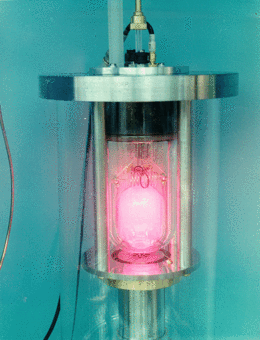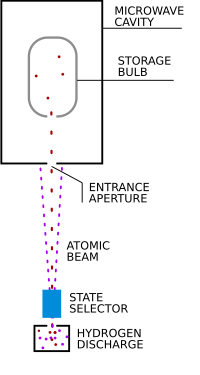Maser


A maser is a device that produces
Modern masers can be designed to generate electromagnetic waves at microwave
The laser works by the same principle as the maser, but produces higher frequency coherent radiation at visible wavelengths. The maser was the precursor to the laser, inspiring theoretical work by Townes and Arthur Leonard Schawlow that led to the invention of the laser in 1960 by Theodore Maiman. When the coherent optical oscillator was first imagined in 1957, it was originally called the "optical maser". This was ultimately changed to laser, for "light amplification by stimulated emission of radiation". Gordon Gould is credited with creating this acronym in 1957.
History
The theoretical principles governing the operation of a maser were first described by
Independently,
For their research in the field of stimulated emission, Townes, Basov and Prokhorov were awarded the Nobel Prize in Physics in 1964.[6]
Technology
The maser is based on the principle of stimulated emission proposed by Albert Einstein in 1917. When atoms have been induced into an excited energy state, they can amplify radiation at a frequency particular to the element or molecule used as the masing medium (similar to what occurs in the lasing medium in a laser).
By putting such an amplifying medium in a
Some common types
- Atomic beam masers
- Ammonia maser
- Free electron maser
- Hydrogen maser
- Gas masers
- Rubidium maser
- Liquid-dye and chemical laser
- Solid state masers
- Ruby maser
- Whispering-gallery modes iron-sapphire maser
- Dual noble gas maser (The dual nonpolar.[7])
21st-century developments
In 2012, a research team from the
It produced pulses of maser emission lasting for a few hundred microseconds.In 2018, a research team from Imperial College London and University College London demonstrated continuous-wave maser oscillation using synthetic diamonds containing nitrogen-vacancy defects.[11][12]
Uses
Masers serve as high precision
During the early 1960s, the
Refrigeration was a two-stage process, with a large Linde unit on the ground, and a crosshead compressor within the antenna. The final injection was at 21 MPa (3,000 psi) through a 150 μm (0.006 in) micrometer-adjustable entry to the chamber. The whole system
Hydrogen maser

The hydrogen maser is used as an
Here is a brief description of how they work:
- First, a beam of atomic hydrogen is produced. This is done by submitting the gas at low pressure to a high-frequency radio wave discharge (see the picture on this page).
- The next step is "state selection"—in order to get some stimulated emission, it is necessary to create a population inversion of the atoms. This is done in a way that is very similar to the Stern–Gerlach experiment. After passing through an aperture and a magnetic field, many of the atoms in the beam are left in the upper energy level of the lasing transition. From this state, the atoms can decay to the lower state and emit some microwave radiation.
- A high resonant frequency of the microwave cavity is tuned to the frequency of the hyperfine energy transition of hydrogen: 1,420,405,752 hertz.[15]
- A small fraction of the signal in the microwave cavity is coupled into a coaxial cable and then sent to a coherent radio receiver.
- The microwave signal coming out of the maser is very weak, a few quartz oscillator.
Astrophysical masers
Maser-like stimulated emission has also been observed in nature from
Extremely powerful masers, associated with
Terminology
The meaning of the term maser has changed slightly since its introduction. Initially the acronym was universally given as "microwave amplification by stimulated emission of radiation", which described devices which emitted in the microwave region of the electromagnetic spectrum.
The principle and concept of stimulated emission has since been extended to more devices and frequencies. Thus, the original acronym is sometimes modified, as suggested by Charles H. Townes,[1] to "molecular amplification by stimulated emission of radiation." Some have asserted that Townes's efforts to extend the acronym in this way were primarily motivated by the desire to increase the importance of his invention, and his reputation in the scientific community.[19]
When the laser was developed, Townes and
Gould originally proposed distinct names for devices that emit in each portion of the spectrum, including grasers (
See also
- List of laser types
- Laser
- X-ray laser
- graser)
- saser)
- Spaser
References
- ^ a b Townes, Charles H. (1964-12-11). "Production of coherent radiation by atoms and molecules - Nobel Lecture" (PDF). The Nobel Prize. p. 63. Archived (pdf) from the original on 2020-08-27. Retrieved 2020-08-27.
We called this general type of system the maser, an acronym for microwave amplification by stimulated emission of radiation. The idea has been successfully extended to such a variety of devices and frequencies that it is probably well to generalize the name - perhaps to mean molecular amplification by stimulated emission of radiation.
- ^ American Institute of Physics Oral History Interview with Weber
- ISBN 978-1420033403.
- .
- .
- ^ "The Nobel Prize in Physics 1964". NobelPrize.org. Retrieved 2020-08-27.
- ^ The Dual Noble Gas Maser, Harvard University, Department of Physics
- S2CID 124247048.
- ^ Palmer, Jason (16 August 2012). "'Maser' source of microwave beams comes out of the cold". BBC News. Archived from the original on July 29, 2016. Retrieved 23 August 2012.
- ^ Microwave Laser Fulfills 60 Years of Promise
- PMID 29565370.
- ^ Scientists use diamond in world's first continuous room-temperature solid-state maser, phys.org
- ^ "Low Noise Amplifiers – Pushing the limits of low noise". National Radio Astronomy Observatory (NRAO).
- ^ Macgregor S. Reid, ed. (2008). "Low-Noise Systems in the Deep Space Network" (PDF). JPL.
- ^ "Time and Frequency From A to Z: H". NIST. 12 May 2010.
- S2CID 26146516.
- Bibcode:1991ASPC...16..163N.
- hdl:10831/91303.
- ISBN 978-0-684-83515-0.
- ISBN 978-0-684-83515-0.
Further reading
- J.R. Singer, Masers, John Whiley and Sons Inc., 1959.
- J. Vanier, C. Audoin, The Quantum Physics of Atomic Frequency Standards, Adam Hilger, Bristol, 1989.
External links
- The Feynman Lectures on Physics Vol. III Ch. 9: The Ammonia Maser
- arXiv.org search for "maser"
- "The Hydrogen Maser Clock Project". Harvard-Smithsonian Center for Astrophysics. Archived from the original on 2006-10-10.
- Bright Idea: The First Lasers Archived 2014-04-24 at the Wayback Machine
- Invention of the Maser and Laser, American Physical Society
- Shawlow and Townes Invent the Laser, Bell Labs
